International Symposium 7–9 juni 2018 Orgelpark Amsterdam:
Clavichord and Organ: Companions for Centuries.
¶ A few impressions on the first day
(Rob van Haarlem, translation: Ellie Dautzenberg.)
Opening speech
Driek Florie, chairman of the NCG, introduces Hans Fidom, director of the Orgelpark, and expresses his appreciation for his putting the Orgelpark at the disposal of the NCG, to enable it to organize the five-yearly (and third) International Clavichord Symposium. Hans welcomes us in this wonderful research space and we are informed about the aim of the Park and its particular instruments, especially about the Utopa Baroque Organ and the Van Straten Organ, built from original ones, the original of the latter dating back to 1497; they will be played during these three days. Finally he spends a few words on the way both instruments have influenced each other for ages and the significance of this for the performance practice. Below a short impression of each item of the program is described.
Impression 1: Early music and Dynamics
By way of the Van Straten Organ Christophe Deslignes gives us an opportunity to experience how players can make use of a varied wind pressure, indeed accompanied by two co-players who work the wind-bags. Christophe deliberately uses the word “co-players”, since the three of them play together as a team. It brings about a new way of thinking and moving. The instrument in question has its wind-bags next to each other and they are worked by hand. Often early organs possess upper wind-bags, to be worked by the feet. Their functions are the realization of crescendo and vibrato. Next we hear the Van Straten organ in Tablatura trium notarum supra tenorem (1448).
After having played the Portative Clavicytherium (Alamanda de la Nonette) and the Dulce Melos (Estampie Janus) Christophe finally plays compositions from and by Conrad Paumann on the Organetto: Ms Lo Add.29887, de Machault and a trouvere song titled Rotruange nouvelle. The small instrument resounds delightfully in the acoustics of the church. Then Christophe plays continuous repetitions of the sequence, but each time in a slightly different way. I was not bored for a moment; I am moved. Then all at a sudden it comes to an end. As Christophe explains, this instrument seeks to realize a soft and sweet tone, which will work if the wind is allowed into the pipes meticulously.
Questions were asked about the way the team communicates, to which the answer was: by listening to one another; another question was about the place of origin of the Organetto, which is unknown.
Impression 2: Mersenne’s clavichord, organ music in clavichord performance in 16th- and 17th-century France
According to Terence Charlston we may assume that in 16th-century France dozens of of clavichords were in existence. Indeed, none of them was ever retrieved. In Mersenne’s Harmonie Universelle (1636) we find a drawing of an instrument of the kind. On the basis of this drawing Peter Bavington built an instrument (for an elucidation on it I refer to the report of the second day). Terence informed us about the design and the effect of the five bridges on the tone characteristics, which produce differences
among the four octaves. By way of five pieces of music greatly different from each other those present had an opportunity to form an opinion about the result. I was struck by the smallness of the tone and perhaps this was why I could not discriminate the above mentioned differences in tone characteristics adequately. As for me, I had wished to hear 18th-century music played on the instrument, preferably from Francois Couperin’s Suites, being music in which his doleful personality was tuned in to his environs (Philippe Beaussant, 1980) and which is of great ‘Kantabilität’ (RvH).
Impression 3: Tackling Bach’s Violin Works at the Clavichord; exploring a tradition of keyboard improvisation in performance
Joel Speerstra reports on the progress of his investigation, based in the question of JSB’s knowledge of the violin and the clavichord playing. When playing his clavichord at home JSB took care to provide the violin parts of his compositions with suitable harmonies, though not too many. Today’s subject-matter is the similarities in the ways in which the players make the strings sound. In playing the clavichord the player has to exert a certain pressure on the strings by way of the tangents on the keys as long as the tone resounds. In playing the violin the bow is used to exert the pressure. The next question is if the technique of violin playing leads to an understanding of learning to play the clavichord as far as physical technique, producing the tone and interpretation are concerned. On the basis of James J. Gibson’s work ‘The Ecological Approach to Perception, 1979’ Joel explained the matter of the most significant aspects of the project in a captivating manner, now and again freely associating with other areas of eastern and western arts and cultures. This way of approach gives him an opportunity to speak of “micro-dynamics”, as far as the fingers are concerned. In this approach “affordance” is the principal concept. Finally Joel plays some of JSB’s violin parts under the key-note of “Bach improvising at home on the pedal clavichord”. The audience is recommended to consider “the intentional and well-aimed manipulation of the relations between key-tone and harmonic tones to the ears of the audience during the performance” as a factor of micro-dynamics.
Break and Dinner
During dinner dr. Bernard Brauchli (Lausanne, Switzerland) is appointed Honorary Member of the NCG. The laudation is delivered by Menno van Delft.
Concert/ Ulrike Davidsson & Joel Speerstra
Part 1: Joel Speerstra
UTOPA BAROQUE ORGAN: Vincent Lübeck (LüBWV 11) and Johann Sebastian Bach (BWV 1080)
Prelude in d minor (LübWV)
Die Kunst der Fuge. Contrapunctus 1 and 2: Fugue, Rectus ; Contrapunctus 3 and 4: Fugue, Inversus
Listening to the prelude was a delightful experience. I was touched by the highly North German intonation of the pipes and I greatly enjoyed the suitable registration.
While listening to the Contrapuncti I noted down my most personal observations like: quite jumpy, not in a singing, vocal way (twice); restless lines; not the proper organ for this kind of music or not a suitable, transparant registration.
Part 2: Ulrike Davidsson & Joel Speerstra
DOUBLE CLAVICHORD: continuation of Die Kunst der Fuge (BWV 1080)
The concert was continued on the Double Clavichord, the instrument that had been introduced already during Joel’s lecture. I quote from my notes: the performance is too hasty to produce a fine tone; I cannot detect “connecting tones”; affects are not made the most of; when is the instrument going to sing? All these observations were made from my own personal perspective as a result of Bernhard Klapprott’s Keynote on “Aspects of Vocality in playing the Clavichord”.
¶ The second day of the jubilee symposium was dedicated to the clavichord.
Over centuries organists practised and taught at home on the clavichord, because practising in church was not possible as a blower’s help was needed. A report by Dorothea Demel with her photographs
The keynote lecture two was given by Bernhard Klapprott: Aspects of vocality in playing the clavichord (eighteenth century sources). Because of its unique qualities to influence the tone the clavichord is the ideal instrument for beginners and all who like to become good players of keyboard instruments (also harpsichord). The clavichord (Clavier) was described as the most influential strung keyboard instrument to develop the vocal style of playing. In 1753 C.P.E. Bach published his “Essay on the True Art of Playing Keyboard Instruments” and his playing the clavichord was extraordinary. His sensitive playing in connecting the tones in a structured legato, imitating the human voice perfectly was praised by the persons who were invited to listen to his playing the Silbermannsches clavier (including Charles Burney, Johann Friedrich Reichardt, Matthias Claudius). Klapprott gave a comprehensive overview over the numerous sources of the art of clavichord playing at that time. Playing-skills can be accomplished on the clavichord with the unique features of “Bebung” (tremolo) a kind of vibrato based on “tenuto”; Tragen der Töne (appoggiato and portamento) sustaining the tones with “Nuance“ (modification of the pitch level). On all keyboard instruments are possible the means of drawing of the fingertips and the new fingering using the thumb (both described and developed by J.S. Bach) and finally the ornamentation as a means to connect tones to compensate the lack of duration of tone length on strung keyboard instruments. Klapprott illustrated the lecture with his fine playing of some examples on the clavichord.
In his lecture “A Stranger in a Foreign Land: The Clavichord in the New World“, Gregory Crowell described the history of clavichord and clavichord playing in the New World. In Mexico in the town Tepotzotlán is still an eighteenth-century clavichord. In 1736 in Philadelphia the organ maker John Clemm (Johann Gottlob Klemm, 1690–1762) made organs and keyboard instruments and later became the teacher of the Moravian David Tannenberg. Probably you know that in 2004 Laurence Libin discovered in one of the three still existing clavichords in the ownership of the Moravians the signature dating from 1761 from the German-American organ maker David Tannenberg (before only his two sketches of a clavichord by him were known). In America people preferred to buy English or the cheaper German clavichords. In 1771 Thomas Jefferson ordered a clavichord in Hamburg, but then bought a pianoforte and later he ordered a clavichord for his daughter Patsy. Crowell presented quite a lot of American owners of clavichords and even square pianos were converted in clavichords. The early revival of clavichords came with Arnold Dolmetsch. After a concert journey though America (with a Hoffmann clavichord) he became head of a department to make early instruments including the clavichord in the Boston piano firm of Chickering (1906). He sold clavichords in four designs until 1910. The clavichord was no more a stranger in the New World and no part of imported European culture but became part of the American culture.
In the next lecture: Gottfried Silbermann and his missing clavichords Lothar Bemmann gave an overview of the history of the cembal d’amour invented by Gottfried Silbermann in 1721 and its modern copies by Ammer, Michael Thomas, Lyndon Taylor, a similar “Klavikantal” by Peter Kraul (1998) and by Eckehart Merzdorf (2003). Bemmann explained the term “Silbermannsches clavier” may have several meanings: the special type of clavichord “Silbermannsches clavier” made by Gottfried Silbermann, a clavichord made by J. H. Silbermann, later it became a synonym for clavichord in general (it means made by any other maker). (To my opinion the term “Silbermannsches clavier” should not be translated in other languages).
Bemmann listed all sources about clavier made by or attributed to Silbermann. In 1746 the Prussian king Friedrich II. ordered from Gottfried Silbermann a piano and forte and a clavier. I found out that there is still existing a copy of a receipt by Silbermann that he had to deliver a “special clavir” with the “piano et forte”. Maybe this instrument was the famous Silbermannsches clavier later owned by C.P.E. Bach. In 1781 C.P.E. Bach sold this instrument to D.E. von Grotthuss. Bemmann was able to trace this instrument until 1856.
In his lecture Bemmann presented a tiny part of clavichord sources he collected of one of his databases. This database of clavichord citations (CLAVICHORD BIBLIO-16.xls) you can find on the website of DCS (www. Clavichord.info).
Olivier Féraud presented in his lecture “Backgrounds to Henry Arnauts de Zwolle’s dulce melos” his new construction from the only source of the instrument described by Henry Arnauts in a Latin book from about 1440. Dulce melos means sweet melody and the instrument is a hammered dulcimer (hackbrett) with keyboard. The writer must have known real instruments of this kind, they were found in France, where he studied and lived some time. In the instrument, the case, keyboard and keylevers being like a clavichord were 12 unison pairs of strings passing over four bridges dividing the octaves (Henry Arnauts gave two layouts for the instrument, in one the bridges are parallel to one another and in the other the bridges are places obliquely). The strings resting on the soundboard were hit by a simple hammer mechanism. The problems which the maker of “lost instruments” have to solve are fifteenth centuries sound aesthetics, mechanical noises, where is the music intended to be played. In this case the instrument is only suited for small rooms and not for concerts. The music for the dulce melos includes dances, estampies, diminuations (Codex Faenza, Buxheimer organ book). Christophe Deslignes played some examples.
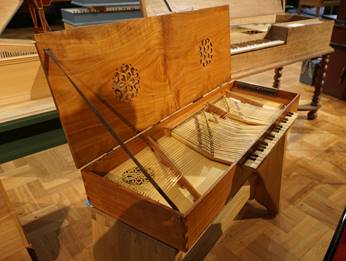
Foto 1: The Dulce Melos made by Oliver Féraud.
Ulrika Davidsson gave an overview over the research project “Dynamic playing” at the Royal Danish Academy of Music. It was a case study programme for young students of the organ or church music department. The study comprised three years 45 minutes per week lessons with three students in a group. In the first-year playing was offered on the pedal clavichord, the second year it was also possible to choose Harmonium and in the third year pedal piano (Pleyel 1880). Each year ended with a symposium. The teaching comprised playing a Bach Triosonata, in which three players played only one voice at a time then they switched positions that in the end they had played all voices. They exercised Duet playing of Goldberg variations an Art of the Fugue, learned to improvise and studied the Eighteen Probestuecke (sample pieces) in six sonatas by C.P.E. Bach. The students gained an improved feeling of touch, sound, technique, musicality and expression of music.
Menno van Delft played in his lecture: Bach and the clavichord, examples from J. S. Bach’s pieces. He tried to group them in four categories: one: really well, two: ok, three: does not work (works with dense polyphony) and four: splendidly well. Category one comprises simple pieces and houses music. He played on a fretted clavichord made by Dick Verwolf the little prelude in C major, the Applicatio (BWV 994) from Clavier Buechlein for W.F. Bach. On his splendid Hass copy van Delft played the Allemande (cat. two) and the second of four Courantes from the first English suite in e-minor, the most “French” of the English suites. Because the lack of time van Delft played some pieces proposed by thearticipants. All works van Delft.
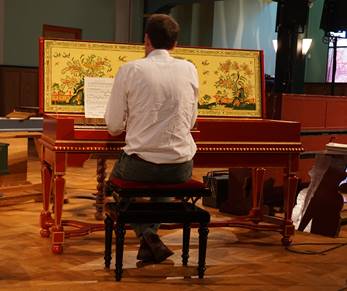
Foto 2: Menno van Delft plays on his Hass clavichord
.
NCG could choose for its thirty first anniversary no better place than the Parkkerk which houses the Orgelpark. On the four church galleries those impressing organs including the newly inaugurated Utopa Baroque Organ (Hildebrandt organ) and on the basement this fine collection of pedal clavichords, clavichords and more. Under the title Building clavichords / introductions to exposed instruments some instruments were presented.
The pedal clavichord of the Schuetz house in Bad Köstritz was made by Volker Platte (table clavichord triple fretted after Pisaurensis and the pedal clavichord developed by Andreas Hermert. Hermert described the pedal part. The rollerboard design was taken from the description by Claas Douwes (1699). The pedal with a short bass octave is triple fretted. Hermert has shown his skills with a lot of interesting solutions e.g. how the pedal may be removed from the corpus. Bernhard Klapprott demonstrated the sound of the pedal.
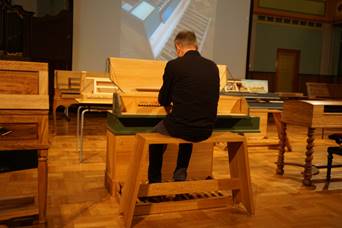
Foto 3: Bernhard Klapprott at the pedal clavichord (Bad Koestritz).
Peter Bavington reconstructed Mersenne`s clavichord after the seventeenth century source “Harmonie Universelle” by Marin Mersenne published in 1637. He pointed out that he is full of doubt in reconstructing an instrument from a drawing. Only in 2001 Maria Boxall described the instrument was drawn in an early form of isometric projection and Mersenne’s description is detailed and not improbable. The case has the proportion of length to width of exactly 3:1. With the help of a French harpsichord engraving from 1699 by La Brèche Bavington found probable dimensions. The clavichord made of walnut and poplar has seventy strings. The five bridges were arranged on a sloping soundboard. The pitch was assumed to be a1=392 Hz. A fretting scheme for the 49 notes had to be worked out (diatonic fretting with notes E and A free). The strings were made of brass and in the range a-c3 in historical iron. The brass tangents have hammered tops and a key guidance by pins. The day before it had been a great pleasure to listen to Terence Charlston playing Mersenne’s clavichord in his lecture-recital.
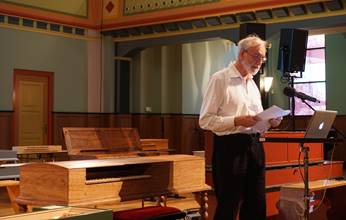
Foto 4: Peter Bavington and Mersenne’s clavichord
Gregor Bergmann presented A New Chamber Organ. The case is like a fine decorated clavichord with four legs and the bellows on the shelf floor. The organ in the clavichord case has one stop, goes from F to a2 (pitch: a fifth above normal). It has 38 keys, with a simple action to play the organ. Like in an old Vienna table organ the air from the bellows goes through the legs. Jos van der Giessen played the organ and we listened to its sweet sound. Gregor Bergmann’s invention is amazing, you like this organ immediately and you cannot believe that by now nobody constructed such an organ. Maybe this symposium encourages him to make a claviorganum, an instrument we did not see in the exhibition.
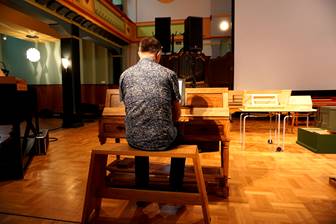
Foto 5: Jos van der Giessen playing Gregor Bergmann’s chamber organ
We had the pleasure to listen to Sander Ruys playing C.P.E. Bach’s Fantasy F-major of the fifth collection for Connoisseurs and Amateurs on a five-octave clavichord based on Silbermann he made himself. Sander Ruys is a skilled clavichord maker, a musicologist and a fine clavichord player.
Participants of the symposium had met for dinner, June 7. NCG awarded the honorary membership to Bernard Brauchli for his outstanding efforts to promote the clavichord. My mind went to the dinners during the symposiums in Magnano which Brauchli organized, our coming together in lectures and day and night recitals, at breakfast and leisure time in the “white house.” And the streets of Magnano filled up with more clavichord enthusiasts than inhabitants.
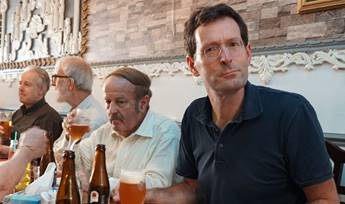
Foto: 6: Menno van Delft and Bernard Brauchli at dinner
Under the title Ars longa – Music for Clavier from the sixteeth to eighteeth century Sigrun Stephan played Jan Pieterszoon Sweelinck (1562-1621) Präludium Toccata (Fitzwilliam Virginal Book) and William Byrd (1543-1623) Pavana Lachrymae (Fitzwilliam Virginal Book) with nice phrasing and technically brilliant. But why did she play these pieces on an eighteenth-century clavichord instead on an earlier fretted one? There were some instruments available and I know she plays very well on instruments in keeping with the time. Stephan played Johann Caspar Ferdinand Fischer’s (1662-1746) Praeludium and Chaconne in G major (Musicalisches Blumenbüschlein) structured and with easiness. The true qualities of her playing J.S. Silbermann’s clavichord made by Matthias Griewisch we could admire in Carl Philipp Emanuel Bach’s (1714-1788) Fantasia in C major (collection for Connoisseurs and Amateurs No. VI) and Wilhelm Friedemann Bach’s (1710-1784) Fantasie in a minor (F 23). She played the pieces really singing was able to show the sound nuances of her fine clavichord. In Fanny Hensel’s (1805-1847) Andante in e minor the dark nuances were played fantastically. Her encore was a fantasy by W.A. Mozart.
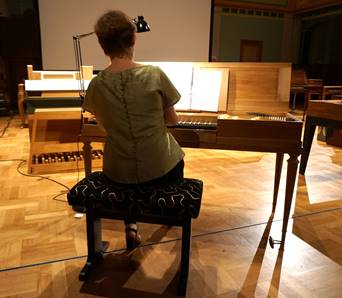
Foto 7: Sigrun Stephan at J.H. Silbermann’ clavichord copy by Matthias Griewisch
In the second part of the concert Ulrika Davidsson played from Carl Philipp Emanuel Bach’s (1714-1788) Eighteen Probestuecke (sample pieces) from C.P.E. Bach’s “Essay on the True Art of Playing Keyboard Instruments” the Sonatas III, IV and V on the double clavichord made by Joel Speerstra. It is always a special delight to listen to so called pieces for learners, when they are played excellently. Davidsson demonstrated us how nice these pieces sound when they are played following C.P.E. Bach’s advice.
Rob van Haarlem, Ede June 13, 2018
¶ Saturday June 9 , the third day of the international symposium at the Orgelpark.
(Henk Glas, translation: Ellie Dautzenberg.)
On this third day Jan Raas is the first speaker, his theme being “the clavichord in the 20th and 21st centuries.”
Every composer wrote modern music in his time. Consequently it is odd that at present going back to early music for the clavichord is prevalent. It also strikes him, that neither modern compositions are reviewed, nor modern sheet music is enclosed in Clavichord International. Jeroen Heijungs suggests that he send in a composition himself.
During the baroque and rococo periods the clavichord was the clavier that was most widely played. Even in the first half of the nineteenth century it was still in use. In the second half of the century it disappeared to make a come-back in the twentieth century.
Jan plays small part of a composition by D.G. Türk and in between frequently cries ‘bravo’. By doing so he earns applause accompanied by ‘bravo’ (‘hear! hear!) Compositions by Bartók and Stockhausen are played as well. One needs a little time to get used, but the pieces sound well on the clavichord. An example is set on how to start composing oneself at the clavichord.
Jean Kleeb is a Brazilian and presents quite different examples of modern music on the clavichord.
His is a small but loud clavichord from a Spanish original from 1800 and he starts playing a variation over a composition from the Buxheimer Orgelbuch and ends playing jazz. By playing chords realized in firm and gentle taps he creates a stimulating rhythm. He cannot help moving continuously and now and again even rises from his chair. On the clavichord it is possible to play flamenco in a way not possible on the guitar. He plays an example of Brazilian music containing a great deal of unstressed syncopations. The same piece is played on the organ and on the the Silbermann clavichord. Jean concludes by playing a piece in which both hands have two different rhythms to play and meet in the course of the piece. In his opinion it is only his own type of clavichord that allows doing this. On the audience’s request part of his knacks is performed on the Gerstenberg clavichord as well.
Franz Danksagmüller has received lists with new compositions for clavichord from among others Lothar Bemman, Paul Simmonds en Anna Maria McElwain. During the past few years several compositions were made and interesting pieces were among them. Examples are shown of sheet music provided with special notation for passing the fingers across the strings.
Dóra Pétery’s presentation is about dynamics on the organ and the clavichord. In addition to loud and soft there are many other possibilities as there are repetition, contrast and echo. A few pieces are played on the Utopa Baroque Organ. Rapid, high notes are combined with heavy bass lines. A silence is broken by firm chords. Short, high tones together with a low bass cause an effect of chinks of light entering a dark room. The audience is treated to organ echos, glissandos and extreme dissonances before the noise changes into electronic tape-music. Once the noise has faded away Dóra appears to have seated herself at a clavichord. She demonstrates the possibilities of the clavichord in a delightful and technically first-rate performance. At first the clavichord sounds soft, but after the ears have got used to the silence it seems to sound louder.
Dalyn Cook’s presentation deals with Lotta van Buren, an American woman who rediscovered the clavichord in the twentieth century. She built and played the instrument. It became an important item in her collection of instruments.
Franjo Bilic playing a canzona by J.S. Bach on the clavichord serves as a basis for his presentation about the clavichord’s use as an educational starting-point for mastering other key instruments, as there are piano, harpsichord and organ. By way of an example he provides the canzona with a great deal of ornaments well-suited for studying at a clavichord. Body posture, weight of the arms, finger positioning are parts of a good technique. On a pedal clavichord one can also practise using the pedals while causing as little background noise as possible.
The final concert is given by Franz Danksagmüller and Menno van Delft. On the Utopa Organ Franz produces extreme contrasts of long and low versus shrill and high tones. Both extremes come together slowly. On the Gerstenberg clavichord chords and slides on the strings are amplified and combined with electronic music. The organ is played once more, but this time by making use of manuals and pedals on the floor, directly in front of the audience. To a clavichord-loving audience it sounds very loud.
The last tones having died down Menno seats himself at the clavichord. While waiting for the organ pump to be turned off the audience’s ears have an opportunity once more to get used to the silence. After a wonderful piece of baroque music by Quirinus van Blankenburg, a composition by Roderik de Man from 2017 is played. The contrast is completed by the final performance of a fantasia by J.P. Sweelinck. This 400-year-old music of the Dutch master is the symbol for the timelessness of good music. After a thunderous applause Franz and Menno together play melodies from Die Zauberflöte as an encore.






